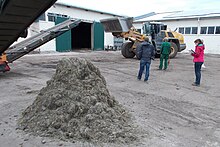Beach clearing
Strandräumgut is a mixture of sand, water, sea grasses , kelp , municipal waste and other substances, which in the cleaning of beaches is applicable. The proportions of the individual substances among one another can vary greatly. Beach cleared items are usually subject to waste legislation, as there is a will to dispose of them.
Accumulation of beach debris
Beach clearing is usually only available on beaches used by tourists. Beaches used for tourism are mostly kept artificially clean in order to allow bathers a pleasant stay. In addition to rubbish left behind by the beach goers themselves, beaches are polluted by debris . There is no legal obligation to clean beaches in Germany, unless the substances are particularly dangerous. Beach cleaning is a voluntary service, which in Germany is mostly carried out by the spa administrations or building yards . By definition, no beach cleaning takes place on natural beaches.
Beach cleaning on the German Baltic coast
On the German Baltic coast, especially the initiation by is seaweed , kelp , seaweed and shells a problem. Depending on the location of the beach, the currents and the direction of the wind, considerable amounts of these substances can land on certain water areas near the shore (bathing water) and certain beaches. The rapid onset of decomposition can lead to considerable odor development and other effects such as musty-muddy shallow water, which many holidaymakers find repulsive. The spa administrations concerned therefore endeavor to keep the beaches clean at all times. As a rule, the beach is cleaned by machine early in the morning, before eight o'clock. For this purpose, the sand cleaning machines used. However, tractors with special in-house designs are also used.
Composition and behavior of wreckage on the German Baltic coast
All beach cleaning processes have in common that when the floating debris and municipal waste are picked up, significant amounts of sand and water are unintentionally picked up. In the first time after the intake of fresh start-up there is essentially drainage of the unbound water. This process can take place directly on the beach, as significant pollution of the seepage water is not to be expected. After the free water has escaped, moisture remains, which is bound to the biomass and the sand fractions. At the same time, the decomposition of the biomass intensifies, which is associated with the release of highly organically polluted seepage water and intense odors. This process should take place on an area where seepage water is collected, otherwise there is a risk of harmful changes to the soil and to ground or surface water.
With increasing storage time, the biomass continues to decompose, so that the proportion of sand comes more and more to the fore. A sieving test with a drum sieve common in the composting industry with different mesh sizes on stored beach clearing material resulted in the following data:
Lagerdauer Gewichtsanteile in % in [a] im Überkorn im Sand 0 41,6 – 62,7 37,3 – 58,4 1 13,0 – 42,6 57,4 – 87,0 2 3,2 – 10,4 89,6 – 96,8
Recycling of beach cleared goods
The organic content of the sifted sand in the sieving test was 0.53% - 1.96% TOC - TM . The levels of chlorides and sulphates were increased, but corresponded to the natural environment of beaches, which are exposed to the salty sea water. The sifted sand was otherwise chemically harmless and aesthetically perfect. It is suitable for a return to the beach. Returning to the beach has the following advantages:
- The transport route is short
- The concept of circular economy is perfectly fulfilled
- Beach decline is prevented, the need for beach wash-ups is reduced
- Apart from the transport costs, there are no other costs
The oversized grain consists of biomass, stones and municipal waste. It can be disposed of directly or treated further.
Other procedures
A variant of the process is the washing of the beach cleared goods. A drum screen is also used for this, but the material to be screened is intensively watered inside the drum. The flowing water means that hardly any sand sticks to the oversized grain. Processes are also known where the beach cleared material is composted in composting plants together with green waste.
criticism
Beach clearance is often mistakenly equated with seaweed. Freshly dried seaweed without sand deposits is a valuable raw material and can be used, for. B. can be used as insulation. Processes of extracting seaweed as a pure raw material from beach clearing have not yet been economically viable.
Individual evidence
- ^ Report on the performance of sieving tests on the beach clearing property of the Baltic seaside resort Boltenhagen, engineering office BAUWAS, Raben Steinfeld, 2015 Presented to the environmental committee of the Northwest Mecklenburg district on October 22, 2015




